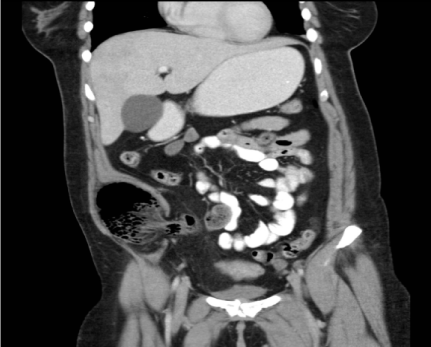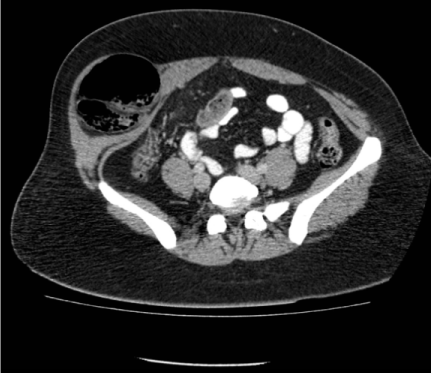Case Report
Large Spigelian Hernia: Case Report and Review of Literature
Bashir MU1, Sbeih MA1, Weerasinghe D1 and Chua A3
1Department of Surgery, Columbia University, USA
2Department of Surgery, Woodhull Medical Center, NYU Langone Medical Center, USA
*Corresponding author: Mohammad U. Bashir, Department of Surgery, Harlem Hospital Center, Columbia University, 506 Lenox ave, New York, NY 10037, USA
Published: 19 Sep, 2016
Cite this article as: Bashir MU, Sbeih MA, Weerasinghe D,
Chua A. Large Spigelian Hernia: Case
Report and Review of Literature. Clin
Surg. 2016; 1: 1124.
Abstract
A Spigelian hernia is a lateral ventral abdominal hernia that occurs with protrusion of a viscus or preperitoneal fat through a defect in the aponeurotic layer between the lateral edges of the rectus
abdominis medially and the semilunar line laterally. Spigelian hernias are relatively uncommon,
and represent only 2% of all abdominal hernias. Due to their overall rarity and evasive presentation,
Spigelian hernias and their associated complications are not well described in literature. We report
here a rare presentation of a Spigelian hernia with large and small bowel strangulated portion in
hernia sac, necessitating emergent laparotomy with bowel resection and repair of the hernia defect.
Keywords: Spigelian hernia; Cecum; Laparotomy; Abdomen
Introduction
A spigelian hernia is the result of an anterior abdominal wall defect. A spigelian hernia results from protrusion of a viscus or preperitoneal fat through a defect in the transversus abdominis muscle, it occurs laterally to the lateral border of the anterior rectus sheath along the semilunar line, where a transition from muscle to aponeurosis occurs. Spigelian hernia management is a challenge to general surgeons. Elective repair of uncomplicated Spigelian hernias can be performed both laparoscopically and by an open technique, with the former reported to be associated with a lower morbidity and shorter hospital stay [1-2]. However, an open approach is more feasible in emergent presentations associated with viscus incarceration, as this prevents undue delays and rapid reduction with possible revival of ischemic tissues, as well as reduction of the rate of iatrogenic bowel injury during trocars insertion for the laparoscopic approach. This case report will present an open repair performed in an emergent situation for incarcerated large spigelian hernia.
Case Presentation
A 49 year-old Hispanic female presented to the emergency department with a 12 hours history
of progressively worsening right lower quadrant pain with multiple episodes of nausea and vomiting
and associated abdominal distention. The pain was reported to be severe and persistent with no
radiation. Further pertinent history included four pregnancies and a surgical history of a caesarean
section about 20 years ago.
On examination, she had a weight of 73 kg with a BMI of 31 kg/m2. Physical examination
revealed a well-developed female in acute distress due to abdominal pain. Her blood pressure was
102/59 but other vital signs were within normal limits. Abdominal exam revealed a distended
abdomen with severe tenderness in the right lower quadrant; a non-reducible firm and tender mass
measuring 10 cm x 10 cm was also palpated in the right lower quadrant, and bowel sounds were
found to be hypoactive. A CT scan of the abdomen revealed a spigelian hernia in the right lower
quadrant containing a dilated cecum (up to 7.1 cm) with collapse of proximal bowel loops, suggesting
mechanical small bowel obstruction (Figure 1,2). Based on the above history and corresponding
radiographic findings, a diagnosis of incarcerated Spigelian hernia was established.
After resuscitation, patient was taken to the operating room for exploratory laparotomy and
hernia repair. Intraoperatively, the hernia sac was first approached through a gridiron incision and
dissection was continued until the hernia sac containing the strangulated cecum was visualized. The
cecum and adjoining portion of the ascending colon as well as the terminal ileum were found to
have wall necrosis. Thereafter, a right hemicolectomy was performed via a separate midline incision
including the distal necrotic portion of the ileum in the resected specimen; a primary ileocolic
anastomosis was performed. The Spigelian hernia defect was then
repaired by primary suture closure using non absorbable sutures with
imbrication of both the internal oblique and external oblique fibers.
Postoperatively, the patient recovered well and her remaining
hospital stay was uneventful. She was discharged on the fifth
postoperative day after tolerating diet and having regular bowel
movements, she continued to follow in surgery clinic with no
recurrence. Surgical pathology was consistent with transmural
necrosis with marked mucosal and submucosal hemorrhage involving
the cecum, ileocecal valve and proximal ascending colon.
Figure 1
Figure 1
CT Abdomen reveals the spigelian hernia with dilated cecum and
entrapped mesentery and omentum- Coronal view.
Figure 2
Discussionn
A spigelian hernia is most likely an acquired abdominal wall
defect, although a congenital predisposition secondary to weakening
of the spigelian fascia from perforating vessels may also contribute
[3,4]. Acquired factors that predispose to a spigelian hernia include
obesity, multiple previous pregnancies, Chronic Obstructive
Pulmonary Disease (COPD) and previous surgeries [3]. These hernias
occur equally in males and females, and present mostly in the fifth to
sixth decade of life [4]. Most spigelian hernias (almost 90%) occur
through the spigelian aponeurosis in a 6 cm wide area extending
from the umbilicus superiorly to the interspinal plane inferiorly
(the line connecting the anterior superior iliac spines); the spigelian
aponeurosis is located lateral to the rectus muscle and is made up of
the transversus abdominis aponeurosis and the posterior leaf of the
internal oblique aponeurosis [5].
Spigelian hernias present mostly with abdominal pain and a
palpable mass in the area of the hernia [3,5]. Incarceration with
spigelian hernias has been reported in 10-24% of patients with
symptomatic spigelian hernia, with the hernia sac usually containing
a portion of the omentum [3,6]; other viscera that have been reported
to be involved include the colon, appendix, ovaries, testes and the
small intestine [6,8]. A pertinent clinical exam and an abdominal
US may both assist in the work up of a Spigelian hernia, however
a CT scan is the most definitive test in establishing a diagnosis of a
spigelian hernia [6,7]. Further, a CT scan also assists in defining the
anatomy of the hernia sac and any associated complications such as
mechanical obstruction.
The management of Spigelian hernias is almost always surgical,
with a low recurrence rate after surgical repair [3,5]. Elective
repair of uncomplicated Spigelian hernias can be performed both
laparoscopically or by an open technique, with the former reported
to be associated with a lower morbidity and shorter hospital stay
[9]. However, an open approach is more feasible in emergent
presentations associated with viscus incarceration, as this prevents
undue delays and rapid reduction with possible revival of ischemic
tissues, as well as reduction of the rate of iatrogenic bowel injury
during trocars insertion for the laparoscopic approach. In our patient,
an open approach to the hernia allowed optimal exposure in a timely
fashion, although the involved portion of the bowel was beyond
salvage. Nevertheless, reduction of the hernia contents expeditiously
prevented further necrosis and a primary anastomosis with healthy
viable margins was achieved.
Conclusion
Spigelian hernias are rare disorder that results from acquired or congenital factors results in defect in the transversus abdominis muscle in anterior abdominal wall and subsequent protrusion of visceral content through the hernia defect. Spigelian hernias carry a significant risk of incarceration and strangulation of sac content. Clinical presentation is often vague, leading to delayed diagnosis. A thorough physical examination along with high clinical suspicion remains crucial in the diagnosis of the Spigelian hernia; additionally, CT scan is the most definitive radiologic test in establishing a diagnosis of a spigelian hernia [6,7]. The management of spigelian hernias is almost always surgical, with a low recurrence rate after surgical repair [3,5]. Spigelian hernias can be repaired in a traditional open fashion or laparoscopically. Multiple intra-abdominal organs have reportedly been found in spigelian hernias, but the presence of a cecum is very rare. Early prompt surgical intervention prevents catastrophic complications of incarcerated spigelian hernias.
References
- Ramones MT, Beech D. Incarcerated Spigelian hernia: a rare cause of mechanical small-bowel obstruction. J Natl Med Assoc. 2010; 102: 731-713.
- Olson RO, Davis WC. Spigelian hernia: rare or obscure? Am J Surg. 1968; 116: 842-846.
- Larson DW, Farley DR. Spigelian hernias: repair and outcome for 81 patients. World J Surg. 2002; 26: 1277-1281.
- Weiss Y, Lernau OZ, Nissan S. Spigelian hernia. Ann Surg. 1974; 180: 836- 839.
- Vos DI, Scheltinga MR. Incidence and outcome of surgical repair of spigelian hernia. Br J Surg. 2004; 91: 640-644.
- GSpangen L. Spigelian hernia. World J Surg. 1989; 13: 573-580.
- Nozoe T, Funahashi S, Kitamura M, Ishikawa H, Suehiro T, Iso Y, et al. Ileus with incarceration of Spigelian hernia. Hepatogastroenterology. 1999; 46: 1010-1012.
- Spangen L. Spigelian hernia. Surg Clin North Am. 1984; 64: 351-366.
- Moreno-Egea A, Carrasco L, Girela E, Martin JG, Aguayo JL, Canteras M. Open vs. laparoscopic repair of spigelian hernia: a prospective randomized trial. Arch Surg. 2002; 137: 1266-1268.


